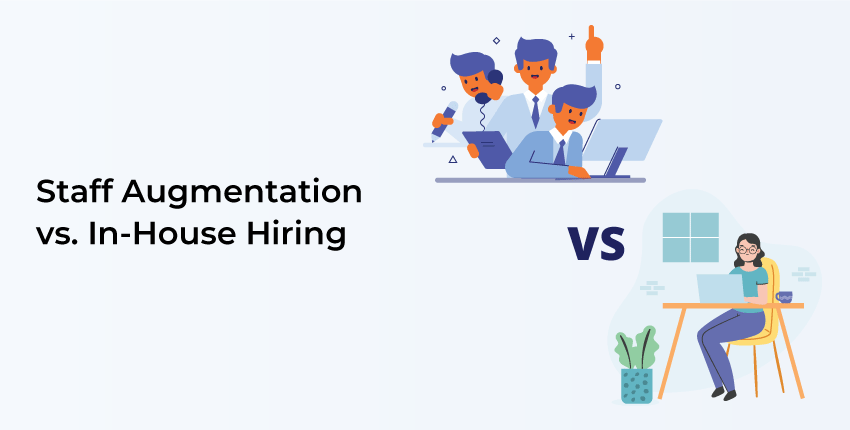- February 5, 2025
- Posted by: 10bits_mexican
- Category: Staff Augmentation

Organizations frequently confront the challenge of deciding between staff augmentation and in-house hiring to satisfy workforce requirements. Organizations need to know about the pros and cons of both staffing ways. Both models have significant advantages and disadvantages, making assessing them critical depending on your business objectives, demands, and project requirements. One of the easiest differences between Staff Augmentation services and in-house hiring is staff augmentation is economical and you get experienced individuals as well. On the other hand, house hiring is costly but provides a stable team for your organization. There are other significant differences also which depend on your needs and resources. Further, this article will discuss the important differences, benefits, and considerations for each type so you can make an informed decision.
What Is Staff Augmentation?
Staff augmentation is the flexible outsourcing method wherein companies hire external workers to work with their own in-house team in carrying out specific projects or activities. This way they get different perspectives and expertise as well.
Third-party agencies generally hire these individuals to provide on-demand expertise without the long-term commitment of full-time employment. This way the organization gets the assistance and the individuals get paid well and have hands-on experience. Staff augmentation is especially useful for short-term projects, scaling teams, and filling talent gaps.
Definition of In-house Hiring
Recruiting employees internally is the traditional method of recruiting full-time staff who work solely for your organization. They are full-time, permanent employees contributing to the long-term business results. In-house teams are especially useful for firms that want complete control over their operations and culture.
In-House Hiring versus Staff Augmentation
1. Project ownership
Hiring in-house means that the company retains full ownership and management of the project. In-house staff are completely integrated into the organization’s culture and objectives, assuring long-term success. This way the information is kept confidential and it does not go out to any person other than the company employees.
Staff Augmentation: While augmented employees work for you, internal management retains responsibility for project delivery. This style is suitable for temporary purposes but may require additional supervision. If you have some temporary projects then Staff augmentation services are best suited for you.
2. Training requirements
In-House Hiring: when you recruit new individuals, you need to provide extensive onboarding and training to ensure alignment with corporate processes and culture. This results in being time-consuming and costly for any organization.
Staff Augmentation: Augmented staff are pre-trained specialists who have the necessary expertise for the project. They have good experience and do not need any specific training. This enables them to contribute immediately and provide impressive results.
3. Technical proficiency and skills
In-House Hiring: While your in-house team can be trained and grown over time, finding and retaining highly talented individuals can be difficult, particularly for specialty roles.
Staff Augmentation: This model enables quick access to specialized talent with the technical expertise needed for certain activities or projects, resulting in speedier and more efficient outcomes.
4. Cost and Fees
In-House Hiring: Indeed, bringing full-time staff could generate lots of expenses: there are recruiting salaries and benefits as well as infrastructure and training. All such spending, however, makes complete sense for a big company, just lesser companies, or startups, for which it would make quite a bit of sense.
Staff Augmentation: It requires agency charges but reduces the advantages related to benefits, training, and long-term contracts, making such solutions cost-effective for project-based needs.
5. Flexibility and Scalability
If an organization needs to scale their in-house team then they have to invest a lot in time and resources. Due to labor rules and ethical concerns, downsizing during lean times might be as difficult.
Staff Augmentation: staff augmentation provides good flexibility to any type of organization. It allows any organization to scale its staff up or down according to project needs. It’s suitable for enterprises with varying workloads.
6. Access to Expertise and Experience.
In-House Hiring: By in house recruitment, the organization gets a workforce with diversified experience. This methodology, however, assures long-term access to expertise once the team has been established.
Staff Augmentation: Staff augmentation provides rapid access to a worldwide talent pool, allowing you to get the exact knowledge you need without making a long-term commitment. This is especially useful for technology-intensive or specialized applications.
7. Risk Management and Time Efficiency.
In-House Hiring: The process of recruiting, onboarding, and training new employees can be time-consuming and may cause project delays. Furthermore, there is a possibility of personnel turnover, which can interrupt workflow.
Staff Augmentation: By employing skilled individuals on demand, you can lessen the likelihood of project delays. Agencies also manage legal compliance and payroll, which reduces administrative load.
Conclusion
It is seen that staff augmentation provides flexibility as well as scalability, while also providing access to placement of specialized talent, with hiring services claiming that they provide long-term team stability along with about the best possible cultural alignment. Businesses will need to analyze their profile timelines, the limitations of the budget, as well as the subsequent expertise required for a more informed conclusion on the best approach to take in their regards.
The best part of it all is that all must comply with the model of hiring, while payroll management efficiency has to ensure proper operation and that the employee is also happy. This is why it is critical for businesses to comply with Payroll Services in the USA, to ensure compliance, reduce administrative burdens and allow business units to work directly in realizing the strategic objectives.
